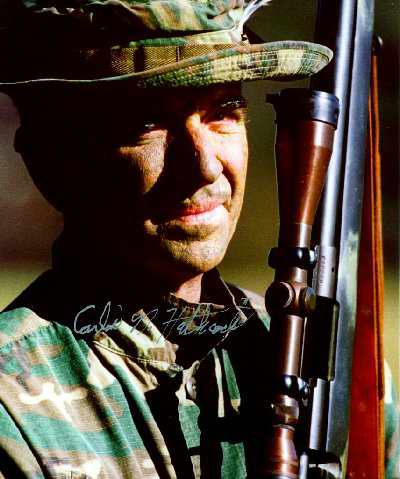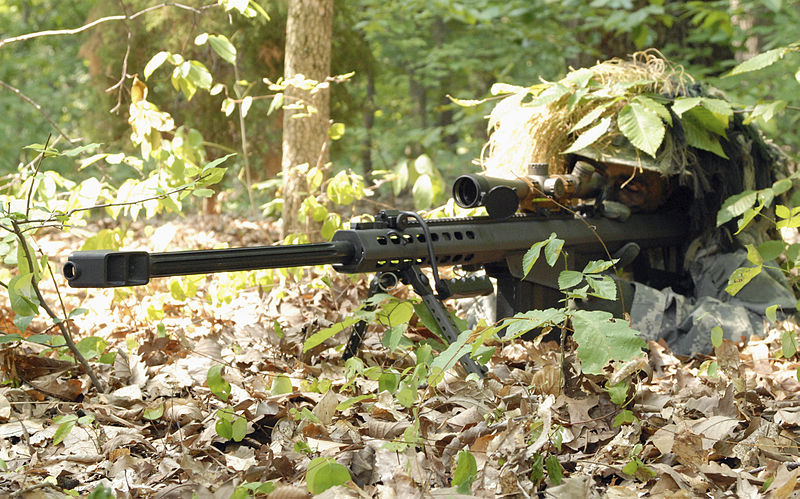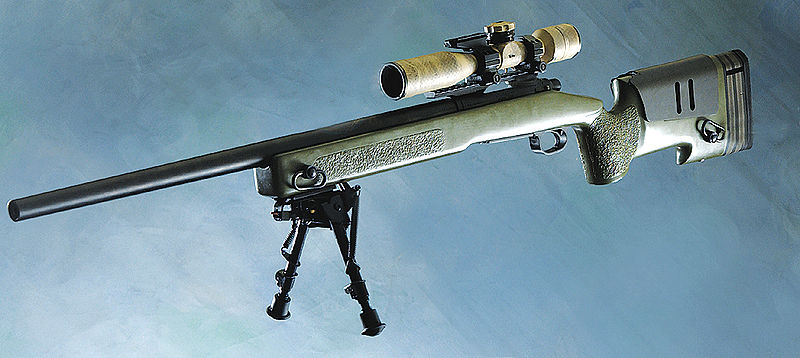In the second of his series on modern sniping for the Osprey blog, Leigh Neville, author of the forthcoming Modern Snipers, details some of the more impressive shots made by snipers during the conflicts in Iraq and Afghanistan.
Coalition snipers have recorded a large number of shots at extreme ranges in recent years. In Afghanistan in particular, the terrain offered the opportunity for engaging the enemy at ranges well beyond the 400 to 600 meter range band that was typical of the more urbanized Iraq where buildings would often break the sniper’s line of sight. Insurgents in Afghanistan would also engage Coalition forces at much longer ranges as they learned that the 5.56x45mm round used in the majority of Coalition carbines and light machine guns was largely ineffective beyond 400 meters.
Snipers (and designated marksmen) became one of the primary responses to such insurgent tactics. The typical sniper rifle could engage out to 800 meters and beyond, and could surgically kill insurgents located within the civilian population. Perhaps not surprisingly, many of the record-breaking long distance sniper shots emerged from the counter-insurgency war in Afghanistan.
 Marine Gunnery Sergeant Carlos Hathcock
Marine Gunnery Sergeant Carlos Hathcock
For some 40 years however, the record for the longest range sniper kill was held by the father of modern sniping, Marine Gunnery Sergeant Carlos Hathcock. During the Vietnam War, Hathcock deployed a .50 cal Browning heavy machine gun with a jury-rigged Unertl 10 power scope to accomplish the longest range confirmed kill of the war and of the twentieth century. Firing single shots from the .50 cal, he killed a Viet Cong insurgent at an incredible 2286 meters.
His feat would stand until Operation Anaconda in eastern Afghanistan in April 2002 when a small team of Canadian Army snipers broke Hathcock’s record twice in two months. The first shot was made by Master Corporal Arron Perry at an astounding 2310 meters. Perry, like Hathcock, had used a .50 cal platform but in Perry’s case it was a McMillan TAC-50 bolt-action anti-material rifle. Barely a month later Perry’s sniping partner, Corporal Rob Furlong, made an even more impressive 2430 meter kill.
Perry and Furlong’s accomplishments are amplified when you consider they were some 10,000 feet up an Afghan mountain and shooting at insurgents located on another mountain! Furlong even heated his bullets in the sun to increase the burn rate of the powder to wring every last inch of range from them (he had also run out of sniper grade ammunition and was using standard issue .50 cal ball which is not known for its pinpoint accuracy). Due to the extreme range, he also had to adjust his shot by aiming some fifteen feet above and to the left of the insurgent machine gun team he was targeting.

McMillan TAC-50 (C15) Long Range Sniper Weapon
Furlong’s first round missed, although the altitude allowed his spotter to read the swirl or vapour trail of the round to provide corrections for his follow-on shots. His second round came closer, hitting one of the packs worn by the insurgents. With the enemy diving for cover, Furlong knew he had one last chance. After pressing the trigger, he waited for an anxious four seconds as the round made its lethal journey before his spotter reported a solid hit on the insurgent machine-gunner and Furlong entered the history books.
The Canadian’s record held until 2009 when it was beaten by British Army Sergeant (then Corporal of Horse) Craig Harrison of the Household Cavalry Regiment in Helmand Province. Operating in Musa Qala, Sergeant Harrison was involved in a number of engagements that day. He firstly suppressed an insurgent mortar spotter at 3000 meters (firing rounds around the spotter until he decided discretion was indeed greater than valour!) before killing two enemy riflemen at just over 750 meters. He then killed a pair of RPG teams at 700 and 1000 meters respectively before finally engaging a PKM machine gun team at the amazing range of 2475 meters.

.338 Lapua Magnum L115A3 Sniper Rifle
Using his .338 Lapua Magnum L115A3 sniper rifle, Harrison fired some seven rounds to ‘range in’ on the targets before dispatching them both with centre of body mass hits to the chest. Another British Army sniper managed a similarly impressive feat several years later, again in Helmand. This time, a sniper with the Coldstream Guards killed six insurgents with a single round from his own .338 L115A3! During a contact with insurgents attempting to overrun an Afghan Army checkpoint, the sniper spotted an insurgent machine-gunner emerging from a creek bed. His commander explained what happened next;
'They were in contact and he was moving to a firing position. The sniper engaged him and the guy exploded. There was a pause on the radio and the sniper said, "I think I’ve just shot a suicide bomber"'. Indeed he had and the ensuing explosion killed another five insurgents behind the sniper’s original target who had been wearing a suicide bomb vest that was detonated by the sniper’s single .338 projectile.
American snipers also recorded some of their most impressive shots in Afghanistan. US Army Sergeant Nicholas Ranstad made an impressive 2092 meter shot with a .50 cal Barrett M107, the longest range kill by a US sniper to date. The record for the longest range shot in Afghanistan may however be held by an Australian commando team from D Company, 2nd Commando Regiment.
 A US Army Sniper using the M107
A US Army Sniper using the M107
Operating on a still-classified mission in Kajaki, Helmand Province, two Australian sniper teams engaged a wanted insurgent high value target. Both teams were using the .50 cal Barrett M82A1 and fired nearly simultaneously in what’s called a ‘command initiated shoot’. It’s not known which rifle delivered the killing blow but one struck the insurgent commander, killing him at an incredible 2815 meters. Such shots are not that unusual with the .50. One of the US special operations snipers interviewed for Modern Snipers also made a 2500 meter shot using the Barrett in Afghanistan.
In Iraq too, snipers made their mark. In 2004, Marine Staff Sergeant Steve Reichert was conducting sniper overwatch for a Marine patrol. Watching through his scope whilst perched on top of an oil storage tank, Reichert spotted something suspicious hidden inside the body of a dead animal lying beside the road. He immediately warned the patrol who discovered wires leading to a suspected IED. Obviously thwarting the insurgents’ plans to ambush the patrol with a command wire IED, the patrol then came under fire from a number of insurgents who attempted to flank the Marines.
Reichert began to level the odds in the patrol’s favour. He spotted a machine gun team some 1600 meters away who were ducking down before popping up to fire from behind a brick wall, thinking the cover would protect them. Reichert chose to fire through the wall using .50 cal Raufoss Mk211 rounds with tungsten steel core penetrators. He knew his shots had struck their targets when he saw a splash of blood coat the wall behind the insurgents.
Some of the most memorable shots in Iraq occurred during the two battles of Fallujah in 2004. Sergeant Herbert B. Hancock, a Marine Reservist Scout Sniper who worked as a fulltime Texas SWAT sniper killed a pair of insurgents operating a light mortar at just under 1000 meters with his 7.62x51mm M40A3, right at the edge of the weapon’s extreme range. Another Marine, Corporal, now Sergeant, John Ethan Place, was also highly effective in Fallujah, killing 32 insurgents. Due to the heavily urbanized nature of Fallujah, Place’s longest shot was a headshot on an insurgent at 470 meters.
 The M40A3
The M40A3
Along with US Marine and Army snipers, snipers from SEAL Teams 3, 5 and 10 were also deployed during the battle including the American Sniper himself, Chief Petty Officer Chris Kyle. He made nineteen kills during the second Fallujah offensive including a 1463 meter shot with his bolt-action .300 Winchester Magnum Mk13 Mod 5 although his longest range kill was an RPG gunner in Ramadi at an astounding distance of 1920 meters. Some of his fellow SEAL snipers had a lucky escape when an Army Bradley mistook them for insurgents and launched a TOW missile at their sniper hide. Luckily the missile failed to explode!
As many readers will be aware, Kyle also holds the distinction for the largest number of kills by a sniper within the US military, all recorded during multiple tours of Iraq. His record however has now been beaten by a British Royal Marines sniper who has notched up a reported 173 kills whilst serving with the Brigade Reconnaissance Force in Helmand Province. Due to operational security concerns, the Royal Marine remains unnamed. With recent operations in Iraq and Syria prominently featuring Coalition special operations snipers, one wonders how long any such grim record may be held.
In the third and final part of the series, Leigh looks at the developments in sniper equipment and techniques since the Second World War.

Comments
You must be logged in to comment on this post. Click here to log in.
Submit your comment